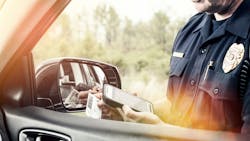Improving Officer Efficiency and Situational Awareness With Rugged Mobile Technology
By Marcus Claycomb, Business Development Manager, Panasonic
A 2021 national survey of police departments found that retirements increased by 45% and resignations went up 18% between April 2020 and April 2021. Even in 2019, 75% of law enforcement agencies were having a harder time recruiting than they had five years prior. On top of this staffing challenge, police departments are confronting a rise in violent crimes, as the U.S. murder rate rose 30% from 2019 to 2020 - the largest single-year increase in more than a century.
As a retired police officer who served for more than twenty years, I understand the departmental challenge of maintaining services with limited resources. While technology can never be a replacement for officers, the right solutions can create new opportunities for efficiency.
A recent study found that public safety professionals believe their agencies need better ways of sharing information and collaborating in real-time. That’s where deploying mobile technology like laptops, tablets, 2-in-1s and handheld devices can help departments streamline everyday tasks and boost the efficiency and effectiveness of data collection and communication.
When deployed properly, mobile technology can give officers more time to serve in their communities and participate in professional development opportunities. In order to achieve maximum ROI, agencies need to carefully consider their intended use cases to choose the right technology to solve their needs today and to prepare for emerging technologies in the years ahead.Top Three Ways Mobile Devices Support Officer Efficiency
From digitizing paper-based processes to facilitating collaboration and enhancing situational awareness, mobile devices play a key role in helping officers stay efficient.
1. Accomplish More at the Point of Interaction
Many police vehicles are equipped with laptops docked inside. While these devices can be helpful for writing reports and conducting research in the vehicle, they limit officer mobility, confining their workflows to the car.
I know firsthand the importance of being able to accomplish more at the point of interaction. Traffic stops, for instance, can consume a considerable portion of an officer’s day, requiring them to complete and file the necessary paperwork from their vehicles. Digitizing that process through mobile devices equipped with automated scanners to image driver’s licenses can streamline that process tremendously.
Mobile devices can also enhance productivity at the station. Detectives benefit from the ability to take a mobile device to an interview and record directly on it as opposed to transcribing content afterwards.
2. Streamline Communication for Coordinated Response
Reliable connectivity is critical to help officers maintain communication and share important information with other first responders for an efficient response. Connectivity issues can arise during storms or in both remote and highly populated settings. Mobile solutions that connect to designated first responder networks, like AT&T’s FirstNet and Verizon Frontline, can help essential workers maintain communication.
Beyond these dedicated networks, deploying different software and applications can give officers the ability to seamlessly collaborate with other first responders during large response missions. When multiple police agencies arrive at a scene—all using different mobile devices and networks—ATAK, a free government-funded software, lets them connect devices in real-time for a coordinated response. Typically, officers at the command level can easily talk and collaborate with other agencies, but officers responding directly to an incident have a harder time communicating in real-time. Applications like Push to Talk permit these officers to easily communicate via talk or text.
The connectivity afforded by mobile devices can also help departments collaborate for day-to-day needs. The City of Mishawaka Police Department, for instance, found themselves relying on mobile devices to conduct remote roll-call meetings in order to keep officers safely distanced during the peak of the pandemic.
3. Boost Situational Awareness
By enhancing officers’ access to real-time information and streamlining communication, mobile devices help them better prepare for a scene. Moving forward, mobile devices will also support the transition to next-generation 911 (NG911). NG911 is poised to transform the mobility and situational awareness of officers by giving civilians the ability to share photos and videos directly with dispatchers and first responders. These capabilities will help officers respond to scenarios more effectively and efficiently and better coordinate with other responders.
Another key component of situational awareness is having a sense of your surroundings. Mobile devices equipped with voice-to-text features allow officers to write reports and look up information through dictation. This lets them keep their eyes on their surroundings as opposed to having their heads down which leaves them more vulnerable.
The ability to accomplish more at the point of interaction, engage in real-time communication and operate with greater levels of situational awareness are critical for an effective response. By helping officers achieve these objectives, mobile devices can lead to more efficient and coordinated operations overall.
Just Add Weather: Key Features to Consider in a Mobile Device
There are a multitude of mobile devices on the market, and finding the right one for your department can be challenging. Rugged design is one of the most important features to consider because officers need to have confidence that their devices will work in any type of environment, especially in mission-critical situations.
Whether it’s extreme heat or cold, rugged devices are built to endure the conditions any environment may bring. At Panasonic, we design our devices to withstand these weather elements through the test of time. Our devices also incorporate features like night mode, letting officers see and operate the keyboard in the dark, in addition to daylight-viewable screens to prevent against glare during high noon. Additionally, our devices support glove-touch functionality, allowing officers to operate the touchscreen even when wearing gloves, and rain mode, which means the touchscreen won’t misinterpret raindrops falling on the screen as an entry.
In addition to extreme weather, some rugged mobile devices are designed specifically to operate in loud settings with enhanced speakers and microphones for accurate speech recognition even amid a siren. Extended battery life means devices can endure long shifts without needing a re-charge.
At Panasonic, we believe Dual-SIM features are also critical to give officers access to multiple mobile networks in the event that one goes down. I’ve responded to scenes where one officer loses signal, threatening the overall collaboration process. That’s where the ability to mesh devices becomes important too, allowing one officer to transmit a signal to others.
Between their durability and enhanced connectivity, rugged mobile devices are crucial to helping officers maintain efficiency in the critical environments where they operate.
Achieving Maximum Benefit for Years to Come
Looking ahead, the ability for mobile devices to pair with emerging technologies, such as 5G and AI, will also help departments experiment with new solutions that can transform their operations for the years ahead.
With data speeds 10x faster than 4G and increased capacity for uploading and downloading data in seconds, 5G technology is poised to transform law enforcement operations. Further, 5G’s strong encryption rate will enable departments to more effectively leverage advanced technologies, like drones, which have already seen some adoption across the industry.
Emerging software applications, when paired with a mobile device, can give officers access to new insight. One platform helps officers communicate with citizens speaking another language, detecting the spoken language and enabling each party to read and listen to translated correspondence.
Mobile devices paired with AI solutions will help officers analyze the abundance of data they’ll be able to collect to ensure it’s mission-specific. This use case will be important, as data only becomes intelligence when it appears in a usable format and a typical law enforcement incident generates more than 1TB of data. The development of NG911 will pose an even greater opportunity for AI to play a role in data insight, as officers gain access to the photos and videos shared by civilians. AI will be critical in not only analyzing data more rapidly, but also prioritizing usable information and presenting it to officers clearly.
Moving Forward
As police agencies maintain mission critical services with fewer staff, rugged mobile devices will be key to helping officers accomplish more at the point of interaction and operate with greater situational awareness for a more coordinated and efficient response. In fact, 98% of officers say their department needs to adopt technologies that improve the quality of reporting, officer safety and community visibility.
In order to achieve maximum ROI from their mobile devices, departments will need to invest time and resources in experimenting with emerging technologies that pair with mobile devices.
Technology innovation is bound to leave a tremendous impact on law enforcement operations and rugged mobile devices will be at the forefront of that transformation, enabling officers to achieve greater efficiency in the short-term, while preparing them to leverage new innovations in the long-term.
About the Author
Marcus Claycomb serves as the Business Development Manager for Public Sector at Panasonic. He supports the fields of law enforcement, fire/rescue, and medical. Specifically, Marcus works with internal and external partners to increase and enhance existing technologies in addition to working with those same partners to create new technologies and products to fill the “need void” in those fields. Marcus started his career in medical & fire rescue and recently retired from a 30 year career in law enforcement. He earned his bachelor’s degree in public administration from Bellevue University and holds an associate’s degree in computer network administration.




